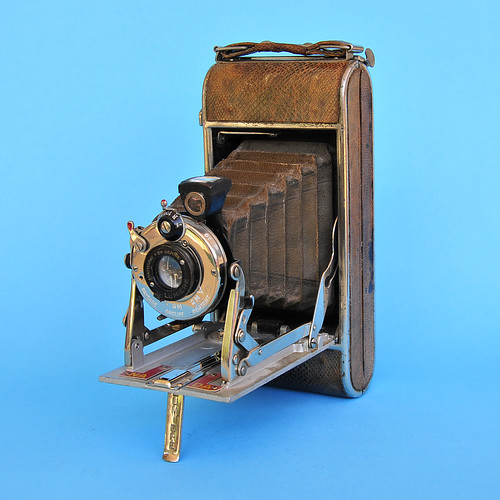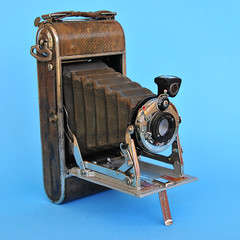Difference between revisions of "Nada"
m (Missing () |
m (typo) |
||
| Line 14: | Line 14: | ||
* [http://www.collection-appareils.fr/x/html/appareil-11250-Lumi%C3%A8re_Nada.html Nada] with black leatherette, f/8.5 Lumière Taxor, and no frame-finder. | * [http://www.collection-appareils.fr/x/html/appareil-11250-Lumi%C3%A8re_Nada.html Nada] with black leatherette, f/8.5 Lumière Taxor, and no frame-finder. | ||
* [http://www.collection-appareils.fr/x/html/appareil-11251-Lumi%C3%A8re_Nada.html Nada] with black leatherette, f/6.3 Anastigmat, and all-black shutter. | * [http://www.collection-appareils.fr/x/html/appareil-11251-Lumi%C3%A8re_Nada.html Nada] with black leatherette, f/6.3 Anastigmat, and all-black shutter. | ||
| − | * [http://www.collection-appareils.fr/x/html/appareil-11252-Lumi%C3%A8re_Nada.html Nada] with reptile leatherette, f/6.3 Anastigmat, and black shutter.</ref> The notes at ''Collection Appareils'' state that it is Lumière's first ''self-erecting'' folding camera. It has a three-speed [[everset shutter]], probably a [[Gitzo_shutters#VARIANT_B3:_red_centre_with_black_ring|Gitzo]] (compare type B3) though not marked as such, and any of several cheapish anastigmat lenses: a 1931 catalogue offers Lumière's own f/6.3 or f/8.5 anastigmats, or Boyer or Roussel f/6.3 alternatives at extra cost.<ref name=Cat31>Pages at ''Collection Appareils'' from a [http://www.collection-appareils.fr/gestion_catalogue/html_bis/affichage_un_catalogue.php?nom=Lumi%C3%A8re&annee=1931 1931 Lumière catalogue], showing the Nada (with the later shutter style): [http://www.collection-appareils.fr/gestion_catalogue/html_bis/affichage_une_page?chemin_image=http://www.collection-appareils.fr/gestion_catalogue/images/1614947544.jpg&id_catalogue=1133355&nom=Lumi%C3%A8re&annee=1931&page=3 Page 5] (shutter etc.), [http://www.collection-appareils.fr/gestion_catalogue/html_bis/affichage_une_page?chemin_image=http://www.collection-appareils.fr/gestion_catalogue/images/1614947550.jpg&id_catalogue=1133356&nom=Lumi%C3%A8re&annee=1931&page=4 Page 6] (general promotion), and [http://www.collection-appareils.fr/gestion_catalogue/html_bis/affichage_une_page?chemin_image=http://www.collection-appareils.fr/gestion_catalogue/images/1614947555.jpg&id_catalogue=1133357&nom=Lumi%C3%A8re&annee=1931&page=5 Page 7] describing the features.</ref> A 1932 catalogue only offers the Lumière lenses.<ref name=Cat32>[http://www.collection-appareils.fr/gestion_catalogue/html_bis/affichage_un_catalogue.php?nom=Lumi%C3%A8re&annee=1932 1932 Lumière catalogue] at ''Collection | + | * [http://www.collection-appareils.fr/x/html/appareil-11252-Lumi%C3%A8re_Nada.html Nada] with reptile leatherette, f/6.3 Anastigmat, and black shutter.</ref> The notes at ''Collection Appareils'' state that it is Lumière's first ''self-erecting'' folding camera. It has a three-speed [[everset shutter]], probably a [[Gitzo_shutters#VARIANT_B3:_red_centre_with_black_ring|Gitzo]] (compare type B3) though not marked as such, and any of several cheapish anastigmat lenses: a 1931 catalogue offers Lumière's own f/6.3 or f/8.5 anastigmats, or Boyer or Roussel f/6.3 alternatives at extra cost.<ref name=Cat31>Pages at ''Collection Appareils'' from a [http://www.collection-appareils.fr/gestion_catalogue/html_bis/affichage_un_catalogue.php?nom=Lumi%C3%A8re&annee=1931 1931 Lumière catalogue], showing the Nada (with the later shutter style): [http://www.collection-appareils.fr/gestion_catalogue/html_bis/affichage_une_page?chemin_image=http://www.collection-appareils.fr/gestion_catalogue/images/1614947544.jpg&id_catalogue=1133355&nom=Lumi%C3%A8re&annee=1931&page=3 Page 5] (shutter etc.), [http://www.collection-appareils.fr/gestion_catalogue/html_bis/affichage_une_page?chemin_image=http://www.collection-appareils.fr/gestion_catalogue/images/1614947550.jpg&id_catalogue=1133356&nom=Lumi%C3%A8re&annee=1931&page=4 Page 6] (general promotion), and [http://www.collection-appareils.fr/gestion_catalogue/html_bis/affichage_une_page?chemin_image=http://www.collection-appareils.fr/gestion_catalogue/images/1614947555.jpg&id_catalogue=1133357&nom=Lumi%C3%A8re&annee=1931&page=5 Page 7] describing the features.</ref> A 1932 catalogue only offers the Lumière lenses.<ref name=Cat32>[http://www.collection-appareils.fr/gestion_catalogue/html_bis/affichage_un_catalogue.php?nom=Lumi%C3%A8re&annee=1932 1932 Lumière catalogue] at ''Collection Appareils''.</ref> |
Early cameras have a plated shutter body as illustrated here, marked with focusing zones ('Paysage' (landscape), 'Groupe', 'Portrait'). Cameras from 1931 onward,<ref name=CA/> are seen with a black-painted shutter. | Early cameras have a plated shutter body as illustrated here, marked with focusing zones ('Paysage' (landscape), 'Groupe', 'Portrait'). Cameras from 1931 onward,<ref name=CA/> are seen with a black-painted shutter. | ||
Latest revision as of 00:57, 20 February 2024

|
| Nada 'Luxe', with f/6.3 lens and no frame finder. image by Dirk HR Spennemann (Image rights) |
The Nada is a folding camera for 6x9cm exposures on 120 film, made by Lumière in 1930-32.[1] The notes at Collection Appareils state that it is Lumière's first self-erecting folding camera. It has a three-speed everset shutter, probably a Gitzo (compare type B3) though not marked as such, and any of several cheapish anastigmat lenses: a 1931 catalogue offers Lumière's own f/6.3 or f/8.5 anastigmats, or Boyer or Roussel f/6.3 alternatives at extra cost.[2] A 1932 catalogue only offers the Lumière lenses.[3]
Early cameras have a plated shutter body as illustrated here, marked with focusing zones ('Paysage' (landscape), 'Groupe', 'Portrait'). Cameras from 1931 onward,[1] are seen with a black-painted shutter. Most cameras have a brilliant finder on the shutter, which pivots for horizontal or vertical orientation, and a folding frame-finder, with cross-pieces, on the body. Some of the examples cited lack the frame finder. The body of the camera appears to be steel, with some chrome-plated brass fittings, but the folding bed is aluminium. This is painted silver grey in most examples, but black in others. The name 'NADA' is on two L-shaped panels at the front of the bed. There is a table-stand, impressed 'Lumiere'. The back of the camera detaches for loading. 'Luxe' examples with snake- or lizard-skin leatherette and matching coloured bellows, as pictured here, are quite common, for the number of examples seen.[1][4] This 'fantaisie' finish added about 25% to the price of the camera.[2]
Lumière's promotion of the camera stresses the ease of use (in much the same way as Ensign's promotion of similar folders like the All-distance Pocket Ensign of the same period). Loading, erecting and even focusing are described as 'automatic' (a very generous understanding of the word: focusing is 'automatic' in the sense that it suffices only to turn the front element until the pointer is at the desired focus distance; loading is 'automatic' in that the camera has a fitting to make it easier to insert the roll - again rather like an Ensign).[2]
Notes
|
| ||||
| images by Dirk HR Spennemann (Image rights) | |||||
- ↑ 1.0 1.1 1.2 Examples, with notes, at Collection Appareils:
- Nada with black leatherette and f/6.3 Lumière Anastigmat.
- Nada with reptile-skin effect leatherette and f/6.3 Lumière Anastigmat.
- Nada with black leatherette, f/8.5 Lumière Taxor, and no frame-finder.
- Nada with black leatherette, f/6.3 Anastigmat, and all-black shutter.
- Nada with reptile leatherette, f/6.3 Anastigmat, and black shutter.
- ↑ 2.0 2.1 2.2 Pages at Collection Appareils from a 1931 Lumière catalogue, showing the Nada (with the later shutter style): Page 5 (shutter etc.), Page 6 (general promotion), and Page 7 describing the features.
- ↑ 1932 Lumière catalogue at Collection Appareils.
- ↑ Nada 'Luxe' with tan snake-skin leatherette and matching bellows, f/8.5 anastigmat, and no frame-finder, sold at the eighth Westlicht Photographica Auction, in November 2005.

